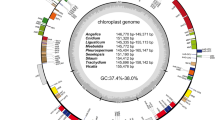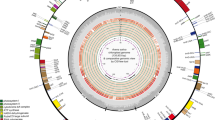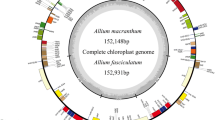Abstract
As a basalmost family of Vitaceae, Chinese wild Vitis species offer key insights into the demographic history of grapes. In this study, we obtained 10 complete chloroplast (cp) genomes from Chinese wild-growing Vitis species based on our whole genome re-sequencing data. These chloroplast genomes ranged from 160,838 to 232,020 bp in size and exhibited typical quadripartite structures. Comparative analyses revealed that inverted repeat (IR) regions are especially abundant and contribute to cp genome arrangements. Phylogenetic analysis of the whole Vitis cp genomes supported three clearly partitioned main origins, in keeping with their geographic distributions, among which East Asian species from China were found to be sister species with Eurasian Vitis species but exhibited significant divergence from the North American group. Two well-supported subgroups were observed within the Chinese wild-growing Vitis species. Among these species, Vitis piasezkii and Vitis betulifolia were closely related species, exhibiting a support rate of 100%. The molecular clock-based divergence time suggested that the earliest split subspecies was Vitis pseudoreticulata, which further indicated that the origin and initial gene pool are located in southern China (the habitat of V. pseudoreticulata is located in the region). Coincidentally, the divergence time was during the Pleistocene period (2.6–0.1 Ma). Due to glacial/interglacial temperature fluctuations, cold-adapted subspecies, e.g., Vitis amurensis, could re-colonize new habitats. Our results may help to elucidate the adaptive radiation of Chinese wild Vitis species in different environments.





Similar content being viewed by others
References
Abbott R (2017) Plant speciation across environmental gradients and the occurrence and nature of hybrid zones: hybrid zones and plant speciation. J Syst Evol 55:238–258
Aradhya M, Koehmstedt A, Prins B, Dangl G, Stover E. (2008) Genetic structure, differentiation, and phylogeny of the genus Vitis: implications for genetic conservation. Acta Hortic:43-49
Aradhya M, Wang Y, Walker M, Prins B, Koehmstedt A, Velasco D, Gerrath J, Dangl G, Preece J (2013) Genetic diversity, structure, and patterns of differentiation in the genus Vitis. Plant Syst Evol 299(2):317–330
Balakirev E, Ayala F (2003) Pseudogenes: are they “Junk” or functional DNA? Annu Rev Genet 37(1):123–151
Bao L, Xu CJ, Jiang WB, Chen LR, Chen KS (2005) Establishment of an AFLP protocol for grape and cultivar distinguishing of Chaoteng and Fujiminori. J Fruit Sci 22(4):422–425 (in Chinese)
Barrett H, Carmer S, Rhodes A (1969) A taximetric study of interspecific variation in Vitis. Vitis 8:177–187
Bi G, Mao Y, Xing Q, Cao M (2017) HomBlocks: a multiple-alignment construction pipeline for organelle phylogenomics based on locally collinear block searching. Genomics 110:18–22
Cai J, Ma PF, Li HT, Li DZ (2015) Complete plastid genome sequencing of four Tilia species (Malvaceae): a comparative analysis and phylogenetic implications. PLoS One 10(11):e0142705
Chang CC, Lin HC, Lin IP, Chow TY, Chen HH, Chen WH, Cheng CH, Lin CY, Liu SM, Chang CC (2006) The chloroplast genome of Phalaenopsis aphrodite (Orchidaceae): comparative analysis of evolutionary rate with that of grasses and its phylogenetic implications. Mol Biol Evol 23(2):279–291
Chen I, Manchester S (2007) Seed morphology of modern and fossil Ampelocissus (Vitaceae) and implications for phytogeography. Am J Bot 94:1534–1553
Chen JM, Fan L, Wang QF, Motley T (2008) Phylogeography of a marsh herb Sagittaria trifolia (Alismataceae) in China inferred from cpDNA atpB-rbcL intergenic spacers. Mol Phylogenet Evol 48:168–175
Comeaux BL, Nesbitt WB, Fantz PR (1987) Taxonomy of the native grapes of North Carolina. Castanea 52(3):197–215
Comstock TB (1909) Foundations of American grape culture. Ence 30(777):714–716
Cosner M, Jansen R, Palmer J, Downie S (1997) The highly rearranged chloroplast genome of Trachelium caeruleum (Campanulaceae): multiple inversions, inverted repeat expansion and contraction, transposition, insertions/deletions, and several repeat families. Curr Genet 31(5):419–429
Davis C, Wurdack K (2004) Host-to-parasite gene transfer in flowering plants: phylogenetic evidence from Malpighiales. Science (New York, N.Y.) 305:676–678
Dierckxsens N, Mardulyn P, Smits G (2016) NOVOPlasty: de novo assembly of organelle genomes from whole genome data. Nucleic Acids Res 45:e18–e18
Dong W, Xu C, Cheng T, Lin K, Zhou S (2013) Sequencing angiosperm plastid genomes made easy: a complete set of universal primers and a case study on the phylogeny of Saxifragales. Genome Biol Evol 5:989–997
Dong W, Liu H, Xu C, Zuo Y, Chen Z, Zhou SJBG (2014) A chloroplast genomic strategy for designing taxon specific DNA mini-barcodes: a case study on ginsengs. BMC Genet 15:138
Douglas SE (1998) Plastid evolution: origins, diversity, trends. Curr Opin Genet Dev 8:655–661
Downie S, Palmer J (2015) Use of Chloroplast DNA Rearrangements in Reconstructing Plant Phylogeny 14–35
Doyle J, Doyle J, Palmer J (1995) Multiple independent losses of two genes and one intron from legume chloroplast genomes. Syst Bot 20(3):272–294
Ellstrand NC, Schierenbeck KA (2000) Hybridization as a stimulus for the evolution of invasiveness in plants? Proc Natl Acad Sci USA 97(13):7043–7050
Fairon-Demaret M, Smith T (2002) Fruit and seeds from the Tienen formation at Doormal Palaeocene-Eocene transition in Eastern Belgium. Rev Palaeobot Palynol 122(1–2):47–62
Fresnedo-Ramírez J, Sun Q, Hwang C-F, Ledbetter C, Ramming D, Fennell A, Walker MA, Luby J, Clark M, Londo J et al (2016) Toward the elucidation of cytoplasmic diversity in North American grape breeding programs. Mol Breed 36(8):116
Gantt J, Baldauf S, Calie P, Weeden N, Palmer J (1991) Transfer of rpl22 to the nucleus greatly preceded its loss from the chloroplast and involved the gain of an intron. EMBO J 10(10):3073–3078
Guisinger M, Kuehl J, Boore J, Jansen R (2011) Extreme reconfiguration of plastid genomes in the angiosperm family Geraniaceae: rearrangements, repeats, and codon usage. Mol Biol Evol 28(1):583–600
Hewitt GM (2000) Hewitt GM.. The genetic legacy of the quaternary ice ages. Nature 405(6789):907–913
Jaillon O, Aury JM, Noel B, Policriti A, Clepet C, Casagrande A, Choisne N, Aubourg S, Vitulo N, Jubin C, Vezzi A, Legeai F, Hugueney P, Dasilva C, Horner D, Mica E, Jublot D, Poulain J, Bruyère C, Billault A, Segurens B, Gouyvenoux M, Ugarte E, Cattonaro F, Anthouard V, Vico V, del Fabbro C, Alaux M, di Gaspero G, Dumas V, Felice N, Paillard S, Juman I, Moroldo M, Scalabrin S, Canaguier A, le Clainche I, Malacrida G, Durand E, Pesole G, Laucou V, Chatelet P, Merdinoglu D, Delledonne M, Pezzotti M, Lecharny A, Scarpelli C, Artiguenave F, Pè ME, Valle G, Morgante M, Caboche M, Adam-Blondon AF, Weissenbach J, Quétier F, Wincker P, French-Italian Public Consortium for Grapevine Genome Characterization (2007) The grapevine genome sequence suggests ancestral hexaploidization in major angiosperm phyla. Nature 449(7161):463–467
Jansen RK, Kaittanis C, Saski C, Lee S-B, Tomkins J, Alverson AJ, Daniell H (2006) Phylogenetic analyses of Vitis (Vitaceae) based on complete chloroplast genome sequences: effects of taxon sampling and phylogenetic methods on resolving relationships among rosids. BMC Evol Biol 6(1):32
Jiang J, Kell S, Fan X, Zhang Y, Wei W, Kang D, Maxted N, Ford-Lloyd B, Liu C (2015) The wild relatives of grape in China: diversity, conservation gaps and impact of climate change. Agric Ecosyst Environ 209:155–163
Katayama H, Uematsu C (2005) Structural analysis of chloroplast DNA in Prunus (Rosaceae): evolution, genetic diversity and unequal mutations. Theor Appl Genet 111(7):1430–1439
Koboldt DC, Chen K, Wylie T, Larson DE, McLellan MD, Mardis ER, Weinstock GM, Wilson RK, Ding L (2009) VarScan: variant detection in massively parallel sequencing of individual and pooled samples. Bioinformatics 25(17):2283–2285
Kong QS (2004) Flora of Chinese grapes. China agriculture technology press, Beijing
Li CL, Cao YL, He YH, Zhang ZW, Zhou MD (1996) Collecting wild Vitis in China. Plant Genetic Resources Newsletter 106:41–42 (in Chinese)
Li S, Jin P, Li H (1992) Study on fruiting characteristics of lateral canes in ‘Kyoho’ grapevines. Acta Horticulturae Sinica 19(2):117–122 (in Chinese)
Li Z, Long H, Zhang L, Liu Z, Cao H, Shi M, Tan X (2017) The complete chloroplast genome sequence of tung tree (Vernicia fordii): organization and phylogenetic relationships with other angiosperms. Sci Rep 7(1):1869
Liang Z, Duan S, Sheng J, Zhu S, Ni X, Shao J, Liu C, Nick P, Du F, Fan P (2019) Whole-genome resequencing of 472 Vitis accessions for grapevine diversity and demographic history analyses. Nat Commun 10:1190
Liu CH (2012) Studies on taxonomy and geographical distribution of China wild grape species. Henan Agricultural University, Zhengzhou (in Chinese)
Liu X (2017) Molecular phylogenetic reconstruction and the evolution history of the genus Populus L. Chinese Academy of Forestry, Beijing (in Chinese)
Liu CH, Feng JC (2011) Discussing on cluster analysis of Chinese wild grape species based on morphological characters. Journal of Plant Genetic Resources 12(6):847–854
Liu SJ, Kong QS (1995) Studies on the taxonomy of wild grape species native to China. Journal of Fruit Science 12(4):224–227 (in Chinese)
Liu C, Shi L, Zhu Y, Chen H, Zhang J, Lin X, Guan X (2012) CpGAVAS, an integrated web server for the annotation, visualization, analysis, and GenBank submission of completely sequenced chloroplast genome sequences. BMC Genomics 13:715
Liu C, Jiang J, Fan X, Zhang Y (2014) The utilization of Chinese wild grape species in production and breeding. J Plant Genet Resour 15:720–727
Liu XQ, Ickert-Bond SM, Nie ZL, Zhou Z, Chen LQ, Wen J (2016) Phylogeny of the Ampelocissus–Vitis clade in Vitaceae supports the New World origin of the grape genus. Mol Phylogenet Evol 95:217–228
Liu LX, Li R, Worth RP, Li X, Li P, Cameron KM, Fu CX (2017) The complete chloroplast genome of Chinese bayberry (Morella rubra, Myricaceae): implications for understanding the evolution of Fagales. Front Plant Sci 8:968
Lohse M, Drechsel O, Kahlau S, Bock R (2013) OrganellarGenomeDRAW—a suite of tools for generating physical maps of plastid and mitochondrial genomes and visualizing expression data sets. Nucleic Acids Res 41:W575–W581
Ma ZY, Wen J, Ickert-Bond SM, Chen LQ, Liu XQ (2016) Morphology, structure, and ontogeny of trichomes of the grape genus (Vitis, Vitaceae). Front Plant Sci 7:704
Ma ZY, Wen J, Ickert-Bond SM, Nie ZL, Chen LQ, Liu XQ (2018a) Phylogenomics, biogeography, and adaptive radiation of grapes. Mol Phylogenet Evol 129:258–267
Ma ZY, Wen J, Tian JP, Jamal A, Chen LQ, Liu XQ (2018b) Testing reticulate evolution of four Vitis species from East Asia using restriction-site associated DNA sequencing. J Syst Evol 56:331–339
Mallet J (2007) Hybrid speciation. Nature 446(7133):279–283
Millen R, Olmstead R, Adams K, Palmer J, Lao N, Heggie L, Kavanagh T, Hibberd J, Gray J, Morden C et al (2001) Many parallel losses of infA from chloroplast DNA during angiosperm evolution with multiple independent transfers to the nucleus. Plant Cell 13:645–658
Milligan B, Hampton J, Palmer J (1989) Dispersed repeats and structural reorganization in subclover chloroplast DNA. Mol Biol Evol 6(4):355–368
Moore MO (1991) Classification and systematics of eastern North American Vitis L. (Vitaceae) north of Mexico. Sida, contributions to botany 14(3):339–367
MooreMJ, Soltis PS, Bell CD, Burleigh JG, Soltis D (2010) Phylogenetic analysis of 83 plastid genes further resolves the early diversification of eudicots. Proc Natl Acad Sci 107:4623–4628
Mullins MG, Bouquet A, Williams LE (1992) Biology of the grapevine. Cambridge University Press, Cambridge
Nadachowska-Brzyska K, Li C, Smeds L, Zhang G, Ellegren H (2015) Temporal dynamics of avian populations during Pleistocene revealed by whole-genome sequences. Curr Biol 25(10):1375–1380
Niu L, He P (1996) Taxonomy classsification of Chinese wild Vitis plants. Acta Horticulturae Sinica 23:209–212 (in Chinese)
Ovcharenko I, Loots GG, Giardine BM, Hou M, Ma J, Hardison RC, Stubbs L, Miller W (2005) Mulan: multiple-sequence local alignment and visualization for studying function and evolution. Genome Res 15(1):184–194
Péros JP, Berger G, Portemont A, Boursiquot JM, Lacombe T (2010) Genetic variation and biogeography of the disjunct Vitis subg. Vitis (Vitaceae). J Biogeogr 38(1):471–486
Poole I, Wilkinson HP (2000) Two early Eocene vines form Southeast England. Bot J Linn Soc 133:1–26
Prabhudas KS, Prayaga S, Madasamy P, Natarajan P (2016) Shallow whole genome sequencing for the assembly of complete chloroplast genome sequence of Arachis hypogaea L. Front Plant Sci 7:1106
Ramezani A, Haddad R, Dorostkar M, Mardi M, Naghavi M (2009) Evaluation of genetic diversity of Iranian grapevine accessions using microsatellite markers. Vitis 48(3):151–152
Saina JK, Li Z-Z, Gichira AW, Liao Y-YJI (2018) The complete chloroplast genome sequence of tree of heaven Ailanthus altissima (mill.)(sapindales: Simaroubaceae), an important pantropical tree. Int J Mol Sci 19:18
Sanderson MJ (1997) A nonparametric approach to estimating divergence times in the absence of rate constancy. Mol Biol Evol 12:1218–1231
Sanderson MJ (2003) r8s: inferring absolute rates of molecular evolution and divergence times in the absence of a molecular clock. Bioinformatics 19(2):301–302
Saski C, Lee S-B, Daniell H, Wood T, Tomkins J, Kim H-G, Jansen R (2005) Complete chloroplast genome sequence of Glycine max and comparative analyses with other legume genomes. Plant Mol Biol 59(2):309–322
Schattner P, Brooks AN, Lowe TM (2005) The tRNAscan-SE, snoscan and snoGPS web servers for the detection of tRNAs and snoRNAs. Nucleic Acids Res 33:W686–W689
Seehausen O (2004) Hybridization and adaptive radiation. Trends Ecol Evol 19(4):198–207
Shaw J, Shafer H, Leonard R, Kovach M, Schorr M, Morris A (2014) Chloroplast DNA sequence utility for the lowest phylogenetic and phylogeographic inferences in angiosperms: the tortoise and the hare IV. Am J Bot 101(11):1987–2004
Soejima A, Wen J (2006) Phylogenetic analysis of the grape family (Vitaceae) based on three chloroplast markers. Am J Bot 93(2):278–287
Spielmann A, Roux E, Allmen J, Stutz E (1988) The soybean chloroplast genome: complete sequence of the rps19 gene, including flanking parts containing exon 2 of rpl2 (upstream), but rpl22 (downstream). Nucleic Acids Res 16(3):1199
This P, Lacombe T, Thomas MR (2006) Historical origins and genetic diversity of wine grapes. Trends Genet 22:511–519
Thomson RC, Wang IJ, Johnson JR (2010) Genome-enabled development of DNA markers for ecology, evolution and conservation. Mol Ecol 19:2184–2195
Tröndle D, Schröder S, Kassemeyer HH, Kiefer C, Koch MA, Nick P (2010) Molecular phylogeny of the genus Vitis (Vitaceae) based on plastid markers. Am J Bot 97(7):1168–1178
Vanin EF (1984) Processed pseudogenes, characteristics and evolution. Biochim Biophys Acta 782:231–241
Wan YZ, Schwaninger H, Li D, Simon CJ, Wang YJ, Zhang CH (2008) A review of taxonomic research in Chinese wild grapes. Vitis J Grapevine Res 47(2):81–88
Wang YH (2018) Chloroplast genome sequences on Vitis: structural organization and phylogenetic analyses. Huazhong Agricultural University, Wuhan
Wang HW, Song G (2010) Phylogeography of the endangered Cathaya argyrophylla (Pinaceae) inferred from sequence variation of mitochondrial and nuclear DNA. Mol Ecol 15(13):4109–4122
Wang FS, Yang DP, Zhang DS, Zhu CS (2000) System study on the genus Vitis L. of China. Jurnal of Tropical and Subtropical Botany 8:1–10 (in Chinese)
Wang WC, Chen SY, Zhang XZ. (2016) Chloroplast Genome Evolution in Actinidiaceae: clpP Loss, Heterogenous Divergence and Phylogenomic Practice. PloS one 11:e0162324
Wen J, Nie ZL, Soejima A, Meng Y (2007) Phylogeny of Vitaceae based on the nuclear GAI1 gene sequences. Botany 85:731–745
Wen J, Xiong Z, Nie Z-L, Mao L, Zhu Y, Kan X-Z, Ickert-Bond SM, Gerrath J, Zimmer EA, Fang X-D (2013) Transcriptome sequences resolve deep relationships of the grape family. PLoS One 8(9):e74394
Wen J, Harris A, Kalburgi Y, Zhang N, Xu Y, Zheng W, Ickert-Bond SM, Johnson G, Zimmer EA (2018) Chloroplast phylogenomics of the New World grape species (Vitis, Vitaceae). J Syst Evol 56(4):297–308
Zecca G, Abbott JR, Sun W-B, Spada A, Sala F, Grassi F (2012) The timing and the mode of evolution of wild grapes (Vitis). Mol Phylogenet Evol 62(2):736–747
Zhang JL, Cao ZY, Ma JF (2009) Screening of cold-resistant seedlings of a Chinese wild grape (Vitis piasezkii Maxim var. pagnucii) native to loess plateau of eastern Gansu province, China, as rootstocks. Sci Hortic 122(1):125–128
Zhang J, Wu X, Niu R, Liu Y, Liu N, Xu W, Wang Y (2012) Cold-resistance evaluation in 25 wild grape species. Vitis 51(4):153–160
Zhao Y, Yin J, Guo H, Zhang Y, Xiao W, Sun C, Wu J, Qu X, Yu J, Wang X (2015) The complete chloroplast genome provides insight into the evolution and polymorphism of Panax ginseng. Front Plant Sci 5:696
Funding
This work was supported by the National Natural Science Foundation of China (31860542), the National Program for Key S & T Project (Grant number 106001000000150012), Major Science and Technology Program of Ningxia Hui Autonomous Region (Grant no. 2019BBF02022-02), and National Key Research and Development Project (Grant no. 2019YFD1002500).
Author information
Authors and Affiliations
Corresponding author
Additional information
Handling Editor: Handling Editor: Hanns H. Kassemeyer
Publisher’s note
Springer Nature remains neutral with regard to jurisdictional claims in published maps and institutional affiliations.
Supplementary information
ESM 1
(XLSX 14 kb)
Rights and permissions
About this article
Cite this article
Xu, G., Xu, W. Complete chloroplast genomes of Chinese wild-growing Vitis species: molecular structures and comparative and adaptive radiation analysis. Protoplasma 258, 559–571 (2021). https://doi.org/10.1007/s00709-020-01585-y
Received:
Accepted:
Published:
Issue Date:
DOI: https://doi.org/10.1007/s00709-020-01585-y




